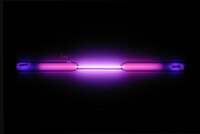
Photo from wikipedia
Oxide-derived copper (OD-Cu) electrodes exhibit higher activity than pristine copper during the carbon dioxide reduction reaction (CO2RR) and higher selectivity toward ethylene. The presence of residual subsurface oxygen in OD-Cu… Click to show full abstract
Oxide-derived copper (OD-Cu) electrodes exhibit higher activity than pristine copper during the carbon dioxide reduction reaction (CO2RR) and higher selectivity toward ethylene. The presence of residual subsurface oxygen in OD-Cu has been proposed to be responsible for such improvements, although its stability under the reductive CO2RR conditions remains unclear. This work sheds light on the nature and stability of subsurface oxygen. Our spectroscopic results show that oxygen is primarily concentrated in an amorphous 1–2 nm thick layer within the Cu subsurface, confirming that subsurface oxygen is stable during CO2RR for up to 1 h at −1.15 V vs RHE. Besides, it is associated with a high density of defects in the OD-Cu structure. We propose that both low coordination of the amorphous OD-Cu surface and the presence of subsurface oxygen that withdraws charge from the copper sp- and d-bands might selectively enhance the binding energy of CO.
Journal Title: Journal of Physical Chemistry C
Year Published: 2017
Link to full text (if available)
Share on Social Media: Sign Up to like & get
recommendations!